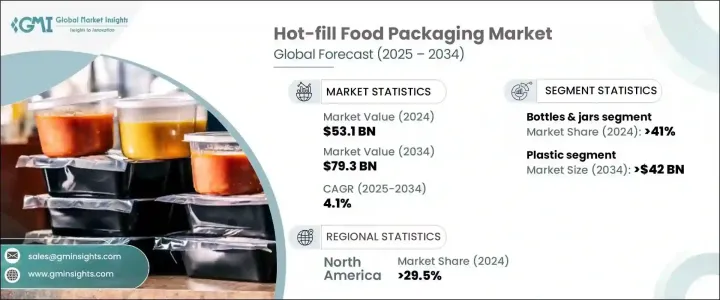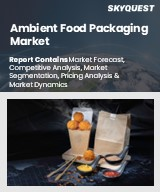
|
시장보고서
상품코드
1684546
핫필 식품 포장 시장 : 시장 기회, 성장 촉진요인, 산업 동향 분석, 예측(2025-2034년)Hot-fill Food Packaging Market Opportunity, Growth Drivers, Industry Trend Analysis, and Forecast 2025 - 2034 |
||||||
세계의 핫필 식품 포장 시장은 2024년 531억 달러로 평가되었고, 2025년부터 2034년까지 연평균 복합 성장률(CAGR) 4.1%로 확대될 것으로 예측됩니다.
소비자가 빨리 먹을 수 있는 식사, 음식, 보존 가능한 식품 등 보다 편리한 식품 선택을 추구함에 따라 핫필 포장 시장은 계속 견인력을 늘리고 있습니다. 이 성장의 원동력이 되고 있는 것은 냉장을 필요로 하지 않고 보존 기간이 긴 제품에 대한 시프트이며, 핫필 포장의 이점과 완전하게 합치하고 있습니다. 이 기술은 맛, 식감 및 영양가를 유지하면서 식품의 품질을 유지하는 효과적인 방법을 제공합니다. 편의성과 지속가능성에 대한 주목을 받고 있는 가운데, 브랜드는 환경 의식이 높은 소비자에게 어필하는 혁신적인 패키징 솔루션을 모색하고 있습니다. 또한 고압처리(HPP)와 진공 씰 등 핫필 기술의 진보가 식품의 보존성과 품질을 향상시켜 시장 확대를 촉진하고 있습니다.

핫필 식품 포장 시장은 제품 유형별로 병 및 항아리, 캔, 파우치, 컵, 통 등으로 구분됩니다. 2024년에는 음료, 소스, 액체 식품의 포장에 널리 사용되어 병병 분야가 시장 점유율의 41%를 차지했습니다. 병 및 항아리는 내구성, 내열성, 오염으로부터 보호하는 능력으로 알려져 있으며 내용물의 신선도와 품질을 보장합니다. 특히 유리나 PET 소재는 투명하기 때문에 안의 상품이 보기 쉬워, 소비자의 신뢰를 높이고 있습니다. 게다가, 이러한 용기는 실용성이 높고, 밀봉이나 재밀봉이 용이하기 때문에 외출처에서의 소비에 편리하고, 바쁜 라이프 스타일에 최적입니다.
| 시장 범위 | |
|---|---|
| 시작 연도 | 2024년 |
| 예측 연도 | 2025-2034년 |
| 시작 금액 | 531억 달러 |
| 예측 금액 | 793억 달러 |
| CAGR | 4.1% |
재료의 유형에 관해서는 핫필 식품 포장 시장은 플라스틱, 유리 및 기타 재료로 분류됩니다. 플라스틱 부문은 CAGR 5%의 견조한 성장이 예상되며 2034년에는 420억 달러에 달할 전망입니다. 플라스틱 포장의 인기는 가볍고 비용 효율적이며 다재다능성이 높기 때문입니다. PET 및 폴리프로필렌(PP)과 같은 소재는 특히 열에 강하며 핫필 공정에 적합합니다. 게다가, 플라스틱 포장은 우수한 장벽 특성을 제공하고 음식 및 음료 제품의 수명과 안정성을 보장하기 위해 장기 보존 가능한 상품을 요구하는 소비자의 선호도와 일치합니다.
지역별 실적에서는 북미가 2024년 세계의 핫필 식품 포장 시장 점유율의 29.5%를 차지했습니다. 미국 시장은 조리된 식품, 주스 및 기타 보존 가능한 식품에 대한 수요 증가로 확대되고 있습니다. 천연 소재나 적은 보존료에 대한 소비자의 기호가 높아지고 있어, 냉장의 필요 없이 식품을 보존할 수 있는 핫필 포장의 이점을 보완하고 있습니다. 북미 시장은 지속가능성에 대한 관심이 높아지고 있으며, 각 브랜드는 친환경 포장을 채택하고 있습니다.
목차
제1장 조사 방법 및 조사 범위
- 시장 범위 및 정의
- 기본 추정 및 계산
- 예측 계산
- 데이터 소스
- 1차 데이터
- 2차 데이터
- 유료 정보원
- 공적 정보원
제2장 주요 요약
제3장 업계 인사이트
- 생태계 분석
- 밸류체인에 영향을 주는 요인
- 파괴
- 장래의 전망
- 제조업체
- 유통업체
- 이익률 분석
- 주요 뉴스 및 대처
- 규제 상황
- 영향요인
- 성장 촉진요인
- 편의점 식품에 대한 수요 증가
- 제품의 유통기한 연장
- 패키지 음료 수요 증가
- 도시화 및 라이프 스타일의 변화
- 보존료 미사용 제품에 대한 기호
- 업계의 잠재적 위험 및 과제
- 포장 무결성 문제
- 제품 품질의 잠재적 변화
- 성장 촉진요인
- 성장 가능성 분석
- Porter's Five Forces 분석
- PESTEL 분석
제4장 경쟁 구도
- 서문
- 기업 점유율 분석
- 경쟁 포지셔닝 매트릭스
- 전략 전망 매트릭스
제5장 시장 추계 및 예측 : 제품 유형별(2021-2034년)
- 주요 동향
- 병 및 항아리
- 캔
- 파우치
- 컵 및 튜브
- 기타
제6장 시장 추계 및 예측 : 소재별(2021-2034년)
- 주요 동향
- 플라스틱
- 유리
- 기타
제7장 시장 추계 및 예측 : 용량별(2021-2034년)
- 주요 동향
- 250ml까지
- 251ml-500ml
- 501ml-1000ml
- 1000ml 이상
제8장 시장 추계 및 예측 : 용도별(2021-2034년)
- 주요 동향
- 소스 및 조미료
- 주스
- 가공식품 및 야채
- RTD 차 및 커피
- 기타
제9장 시장 추계 및 예측 : 지역별(2021-2034년)
- 주요 동향
- 북미
- 미국
- 캐나다
- 유럽
- 영국
- 독일
- 프랑스
- 이탈리아
- 스페인
- 러시아
- 아시아태평양
- 중국
- 인도
- 일본
- 한국
- 호주
- 라틴아메리카
- 브라질
- 멕시코
- 중동 및 아프리카
- 남아프리카
- 사우디아라비아
- 아랍에미리트(UAE)
제10장 기업 프로파일
- Amcor
- Aptar
- Berry Global
- Borealis
- Evertis
- Graham Packaging
- Guala Pack
- Impact Consumer Products
- Imperial Packaging
- Kaufman Container
- Klockner Pentaplast
- MJS Packaging
- O Berk
- Pipeline Packaging
- Pretium Packaging
- Resilux
- Smurfit Kappa
- Sonoco Products
- Tadbik
- Teinnovations
The Global Hot-Fill Food Packaging Market reached USD 53.1 billion in 2024 and is projected to expand at a CAGR of 4.1% from 2025 to 2034. As consumers demand more convenient food options like ready-to-eat meals, beverages, and shelf-stable food items, the market for hot-fill packaging continues to gain traction. This growth is fueled by a shift toward products that offer longer shelf life without requiring refrigeration, aligning perfectly with the advantages of hot-fill packaging. The technology provides an effective method of preserving the quality of food products while maintaining flavor, texture, and nutritional value. With an increasing focus on convenience and sustainability, brands are exploring innovative packaging solutions that appeal to eco-conscious consumers. Moreover, advances in hot-fill technology, including high-pressure processing (HPP) and vacuum sealing, are driving market expansion by improving food preservation and quality.

The hot-fill food packaging market is segmented by product type into bottles and jars, cans, pouches, cups and tubs, and others. In 2024, the bottles and jars segment accounted for 41% of the market share, driven by their widespread use in packaging beverages, sauces, and liquid food products. Bottles and jars are known for their durability, heat resistance, and ability to protect against contamination, ensuring the freshness and quality of the contents. Their transparent nature, particularly in glass and PET materials, enhances consumer trust by allowing easy visibility of the product inside. Furthermore, these containers are highly practical, offering convenience for on-the-go consumption, as they are easy to seal and reseal, making them ideal for busy lifestyles.
| Market Scope | |
|---|---|
| Start Year | 2024 |
| Forecast Year | 2025-2034 |
| Start Value | $53.1 Billion |
| Forecast Value | $79.3 Billion |
| CAGR | 4.1% |
When it comes to material type, the hot-fill food packaging market is categorized into plastic, glass, and other materials. The plastic segment is expected to grow at a robust CAGR of 5%, reaching USD 42 billion by 2034. Plastic packaging's popularity stems from its lightweight, cost-effective nature and versatility. Materials such as PET and polypropylene (PP) are especially resistant to heat, making them well-suited for hot-fill processes. Additionally, plastic packaging provides excellent barrier properties, ensuring the longevity and stability of food and beverage products, which aligns with consumer preferences for long-lasting, shelf-stable items.
In terms of regional performance, North America accounted for 29.5% of the global hot-fill food packaging market share in 2024. The U.S. market is expanding due to an increased demand for ready-to-eat meals, juices, and other shelf-stable food products. There is a rising consumer preference for natural ingredients and fewer preservatives, which complements the benefits of hot-fill packaging in preserving food without the need for refrigeration. The market in North America is also being fueled by a growing focus on sustainability, prompting brands to adopt eco-friendly packaging alternatives.
Table of Contents
Chapter 1 Methodology & Scope
- 1.1 Market scope & definitions
- 1.2 Base estimates & calculations
- 1.3 Forecast calculations
- 1.4 Data sources
- 1.4.1 Primary
- 1.4.2 Secondary
- 1.4.2.1 Paid sources
- 1.4.2.2 Public sources
Chapter 2 Executive Summary
- 2.1 Industry synopsis, 2021-2034
Chapter 3 Industry Insights
- 3.1 Industry ecosystem analysis
- 3.1.1 Factor affecting the value chain
- 3.1.2 Disruptions
- 3.1.3 Future outlook
- 3.1.4 Manufacturers
- 3.1.5 Distributors
- 3.2 Profit margin analysis
- 3.3 Key news & initiatives
- 3.4 Regulatory landscape
- 3.5 Impact forces
- 3.5.1 Growth drivers
- 3.5.1.1 Rising demand for convenience foods
- 3.5.1.2 Extended shelf life for products
- 3.5.1.3 Growing demand for packaged beverages
- 3.5.1.4 Urbanization and changing lifestyles
- 3.5.1.5 Preference for preservative-free products
- 3.5.2 Industry pitfalls & challenges
- 3.5.2.1 Packaging integrity issues
- 3.5.2.2 Potential changes in product quality
- 3.5.1 Growth drivers
- 3.6 Growth potential analysis
- 3.7 Porter's analysis
- 3.8 PESTEL analysis
Chapter 4 Competitive Landscape, 2024
- 4.1 Introduction
- 4.2 Company market share analysis
- 4.3 Competitive positioning matrix
- 4.4 Strategic outlook matrix
Chapter 5 Market Estimates & Forecast, By Product Type, 2021-2034 (USD Billion & Kilo Tons)
- 5.1 Key trends
- 5.2 Bottles & jars
- 5.3 Cans
- 5.4 Pouches
- 5.5 Cups & tubs
- 5.6 Others
Chapter 6 Market Estimates & Forecast, By Material, 2021-2034 (USD Billion & Kilo Tons)
- 6.1 Key trends
- 6.2 Plastic
- 6.3 Glass
- 6.4 Others
Chapter 7 Market Estimates & Forecast, By Capacity, 2021-2034 (USD Billion & Kilo Tons)
- 7.1 Key trends
- 7.2 Up to 250 ml
- 7.3 251 ml to 500 ml
- 7.4 501 ml to 1000 ml
- 7.5 Above 1000 ml
Chapter 8 Market Estimates & Forecast, By Application, 2021-2034 (USD Billion & Kilo Tons)
- 8.1 Key trends
- 8.2 Sauces & condiments
- 8.3 Juices
- 8.4 Processed food & vegetables
- 8.5 RTD teas and coffees
- 8.6 Others
Chapter 9 Market Estimates & Forecast, By Region, 2021-2034 (USD Billion & Kilo Tons)
- 9.1 Key trends
- 9.2 North America
- 9.2.1 U.S.
- 9.2.2 Canada
- 9.3 Europe
- 9.3.1 UK
- 9.3.2 Germany
- 9.3.3 France
- 9.3.4 Italy
- 9.3.5 Spain
- 9.3.6 Russia
- 9.4 Asia Pacific
- 9.4.1 China
- 9.4.2 India
- 9.4.3 Japan
- 9.4.4 South Korea
- 9.4.5 Australia
- 9.5 Latin America
- 9.5.1 Brazil
- 9.5.2 Mexico
- 9.6 MEA
- 9.6.1 South Africa
- 9.6.2 Saudi Arabia
- 9.6.3 UAE
Chapter 10 Company Profiles
- 10.1 Amcor
- 10.2 Aptar
- 10.3 Berry Global
- 10.4 Borealis
- 10.5 Evertis
- 10.6 Graham Packaging
- 10.7 Guala Pack
- 10.8 Impact Consumer Products
- 10.9 Imperial Packaging
- 10.10 Kaufman Container
- 10.11 Klockner Pentaplast
- 10.12 MJS Packaging
- 10.13 O Berk
- 10.14 Pipeline Packaging
- 10.15 Pretium Packaging
- 10.16 Resilux
- 10.17 Smurfit Kappa
- 10.18 Sonoco Products
- 10.19 Tadbik
- 10.20 Teinnovations



















